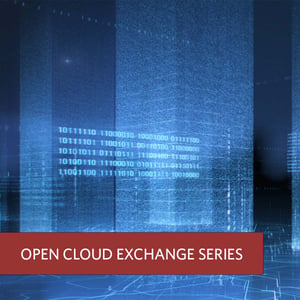
The Open Cloud Exchange: What Is It and Why Use It?
Enterprises pursue digital transformation (DX) to keep up with requirements of cloud migration, remote work, cybersecurity, compliance and growth and to establish a competitive advantage. The pace of DX likely will accelerate. Research found that 59% of tech buyers said they planned to be “mostly” (43%) or “all” (16%) in the cloud in 18 months, up from 38% who say they are mostly or all in the cloud today.[1]
While relationships with cloud service providers (CSPs) are a big part of DX, so are relationships with other enterprises and service providers. This is why the Open Cloud Exchange® (OCX) should be part of your DX strategy. It enables simple, reliable and cost-effective connections to third parties while increasing your operational flexibility and agility.
Why enterprises join the Open Cloud Exchange
Enterprises now run hybrid, multisite and/or multi cloud environments – 45% of organizations are using two to three cloud infrastructure providers.[2] Reducing complexity is a top priority. For this and other reasons, enterprises turn to colocation, interconnection and the OCX:
- Colocation provides a secure, resilient and scalable compute/storage environment complementing on-premises and public cloud and eliminates legacy data center build-outs and data egress fees.
- Interconnection provides low-latency traffic/data exchange among connected parties.
- The OCX provides enterprise-class connectivity services and automation within the data center. Enterprises, managed service providers, service integrators, network service providers and the hyperscale cloud service providers (CSPs) can connect virtually.
The OCX is a mature exchange that’s been running for eight years and has been enhanced during that time period. Enterprises using the OCX can simplify their networking requirements and cloud architectures and capture related benefits.
How the OCX supports infrastructure and operational goals
Connectivity has bubbled up to the top of decision lists. Why? Because the right connectivity choices support your cost, security, performance and scalability objectives. The wrong connectivity choices can add unnecessary expense and intensify operational challenges. Here’s why.
CSPs like Google Cloud, AWS, Oracle Cloud and Microsoft Azure don’t allow direct access into the infrastructures where the clouds live. Instead, they provide aggregation points (we call these native onramps) with a few, trusted colocation providers, one of which is CoreSite. All public cloud access happens through an aggregation point.
Think about the implications of a meandering route to an onramp: increased latency, variable throughput and performance, and security issues – especially for internet traffic. With native onramp connectivity, you can expect these and other benefits compared to connectivity through the internet:
- Highest speed application performance
- Superior security
- Month-to-month service fees with no long-term commitments
- Consolidated billing
- Management and control using a single console
What obstacles slow adoption of modern connectivity
Enterprise IT teams are accustomed to consuming cloud services over the internet. It’s an entrenched, expensive habit that is no longer the best option for many DX use cases or infrastructure strategies. Nor is consuming the cloud through an onramp-less colocation provider. Some decision makers are reluctant to take on what they see as a major infrastructure overhaul, or they’re skeptical of a different approach. Or, they’re not aware they can save up to 70% of data egress costs [3], in addition to the outcomes described above, with OCX connectivity.
This blog is the first in a series about the OCX. Stay tuned to learn about use cases, deployment use cases and benefits. To learn more right now, check out the Open Cloud Exchange.
[1] InfoWorld, The 2020 IDG Cloud Computing Survey, June 8, 2020.
[2] Source: The Information, Trends in Cloud Adoption, May 3, 2021.
[3] Costs savings are based on CoreSite cost comparisons using publicly available and private information and/or CoreSite customer reported costs savings and may not be indicative of the costs savings that may be experienced by every customer that switches to the applicable CoreSite service.









